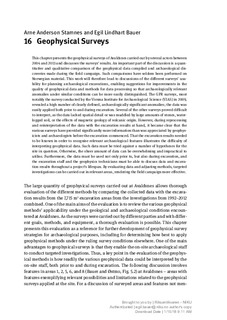| dc.description.abstract | This chapter presents the geophysical surveys of Avaldsnes carried out by several actors between 2004 and 2013 and discusses the surveys’ results. An important part of the discussion is a quantitative and qualitative comparison of the geophysical data compiled and archaeological discoveries made during the field campaign. Such comparisons have seldom been performed on Norwegian material. This work will therefore lead to discussions of the different surveys’ usability for planning archaeological excavations, enabling suggestions for improvements in the quality of geophysical data and methods for data processing so that archaeologically relevant anomalies under similar conditions can be more easily distinguished. The GPR surveys, most notably the survey conducted by the Vienna Institute for Archaeological Science (VIAS) in 2009, revealed a high number of clearly defined, archaeologically significant anomalies; the data was easily applied both prior to and during excavation. Several of the other surveys proved difficult to interpret, as the data lacked spatial detail or was muddled by large amounts of stones, waterlogged soil, or the effects of magnetic geology of volcanic origin. However, during reprocessing and reinterpretation of the data with the excavation results at hand, it became clear that the various surveys have provided significantly more information than was appreciated by geophysicists and archaeologists before the excavation commenced. That the excavation results needed to be known in order to recognise relevant archaeological features illustrates the difficulty of interpreting geophysical data. Such data must be tried against a number of hypotheses for the site in question. Otherwise, the sheer amount of data can be overwhelming and impractical to utilise. Furthermore, the data must be used not only prior to, but also during excavation, and the excavation staff and the geophysics technicians must be able to discuss data and excavation results throughout a project’s lifespan. By evaluating data and adjusting methods, targeted investigations can be carried out in relevant areas, rendering the field campaign more effective. | nb_NO |
